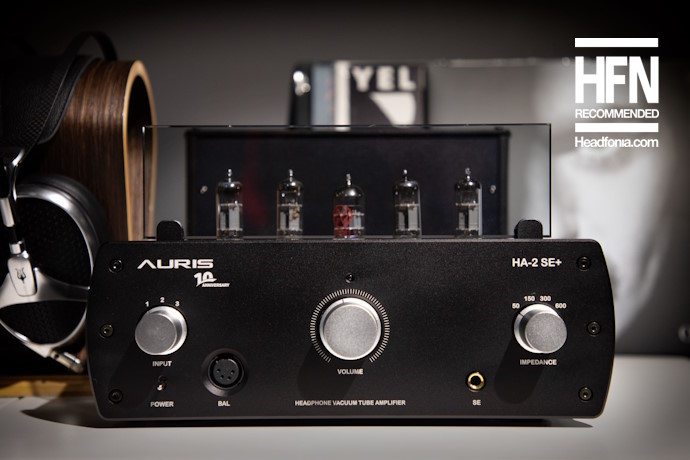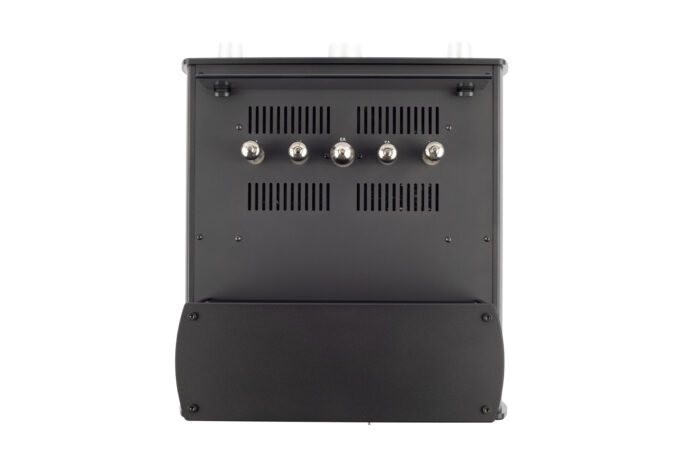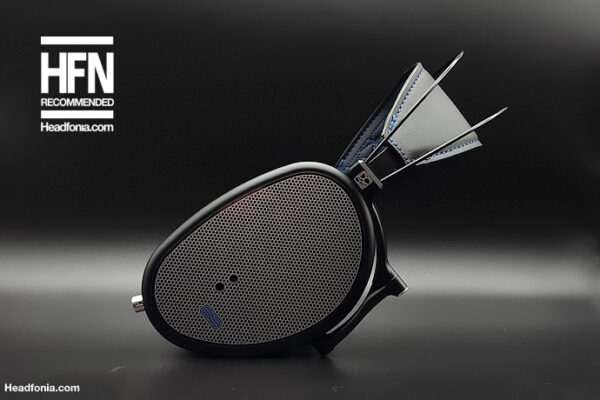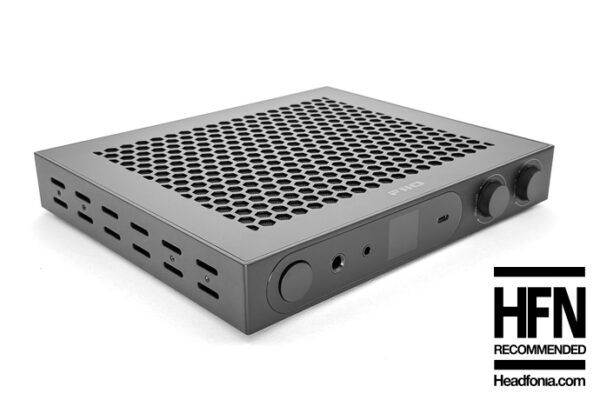We already know that this latest Auris amplifier is a perfect match for high impedance dynamic driven headphones, so let’s find out how it performs with the typical and popular orthodynamics. The next headphone is the Meze Audio Liric, a closed back headphone. It’s another low impedance isodynamic headphone that is easy to drive and on the Liric sounds its best, with almost any source. On the 50Ohm setting, and in Single-End mode, the Liric sounds, clean, precise and it has excellent resolution and layering. For a closed back headphone, this combi sounds spacious and natural. You from top to bottom get a full sound with excellent bass and mid body. The top end is a bit slower and soft in this setup (like the vocals), but it never feels the Liric is underperforming. Like with the Arya Stealth, this is an easy to like signature, with a sound that it soft on the ear. Bass is controlled and always has bigger presence. It’s fun and musical but you also get enough precision and technicalities. As before, the sound signature for my ears in this combo could be a bit more sparkling and energetic, with a higher level of clarity.
Last planar magnetic headphone in this section is the high-end ZMF Caldera. With its 60Ohm impedance, I prefer the HA2-SE+ on the 50Ohm setting. This combo sounds good with a natural but more neutral amount of body, a high technical level and a soft musical delivery. That said, when you hook up the Caldera to a higher end amplifiers such as the Headonia or Feliks Audio Envy, you will see and hear it can perform even better. Think clarity, precision, resolution, extension, etc. The HA2-SE+ is a really good amplifier, but it has its limits, just like with the HD 800 S. That’s perfectly ok and normal however. I will be doing a full Caldera review soon!
Last but not least is the HEDD Audio HEDDphone with its AMT technology and 42Ohm impedance. I in general would not think of this amplifier for this type of headphone, but you never know. Of course I’m using the 50Ohm setting again here but the HEDDphone sounds rather slow, dark and dare I say somewhat muffled. I can’t find the things I like about the HEDDphone in this combo, and so it’s not something I would recommend using.
Sound – Comparisons
For the comparison part with Auris and other brand amplifiers, I used the Sennheiser HD 800 S headphone and the DAC used is the Aquarius, all connected in balanced mode, except for the original HA2-SE.
Auris HA2-SE
The original HA2-SE still is the prettiest of the HA2-SE series, but it at the same time is the least strong from a technical point of view. The Senn here sounds best with the 300Ohm setting, and you get a full sound from top to bottom. The sound is more intimate and even though it has an airy, natural feel to it, the sound stage depth and width is rather limited.
This to me still is the most warm, smooth and tube sounding amplifier of the three. It’s a full bodied sound, but the resolution, precision and extension just doesn’t cut it anymore today. Auris Audio has improved and moved on. The HA2-SE is discontinued, but if you like a real warmer tube sound and like rolling tubes without needing the best technicalities, then check out the 2nd hand market.
Auris HA2-SF
The technical level of the SF version is higher compared to the original SE’s level. At the same time you lose that typical tube smoothness and warmth from the SE, it’s give and take. The SF has more or less the same tuning as the SE+, with a technical level that is almost on par. You get a wide and deep sound stage, great PRaT, clarity and precision.
The really nice thing about the SE+ is that it compared to the SF has more tube influence. The delivery is smoother and there is that hint of warmth giving the SE+ a more romantic timbre, especially in the mids. I do also feel that the note extension, decay and spaciousness of the SE+ has improved vs the SF-version. To me the SE+ is the clear winner.
Feliks Audio Euforia EVO
The award winning Euforia EVO is one of the top contenders in its price class when looking at OTL amplifiers. The HD800’s synergy with the Euforia evo is excellent, and it’s playing at a very high technical level as you would expect. You do get the wide and deep soundstage, airy presentation, and highly revealing signature, but it’s more neutral and scores just a little less in the excitement department. This combo do is nice as it is musical and technically strong.
Compared to the HA2-SE+ these are very close from a technical point of view. The EVO has the warmer and more tube like signature especially in the mids, and the better note extension and decay. The Auris has the best speed, tightness, clarity and energy/sparkle. The vocal presentation in both amps is also different. With the HA2-SE+ they have more energy where they in the EVO has a softer delivery.
I can easily recommend both amplifiers. It basically depends if you prefer clarity and a more vocal energy, or tube smoothness/warmth with gorgeous mid timbre.
End Words
The Auris Audio HA2-SE+ is the third version already of the HA2-series, and to my ears it is the best performing and sounding of them all.
The SE+ takes a bit of the tube warmth and smoothness of the HA2-SE and combines that with the technical performance of the SF. Actually, it has an even higher technical level than the SF has. Luckily Auris Audio never forgets that engagement and musicality are very important aspects as well, so you get a beautiful mix of everything.
The HA2-SE+ is an amplifier that works extremely well with dynamic headphones, but you can also plug in your favorite planar headphone as well. The price/quality ratio of the HA2-SE+ amplifier is very good and you will really enjoy the SE+ with most headphones. The new SE+ replaces the SF version on our list of Best Headphone Amplifiers, where all our Recommended Buys are listed.
Pro
–Price/quality ratio. Perfect mid-fi
–Loves dynamic driven headphones, but planars work nicely as well
–Nice mix of musicality & technicalities
–Excellent pre for speaker system
Con
–Design/materials used (though personal)
–Limited tube rolling impact
Page 1: Auris Audio, HA@-series, HA2-SE+, Tubes, Design & Build Quality
Page 2: Lay-out, Specifications, Sound Pt. 1
Page 3: Sound Pt. 2, End words, Summary










Mike I
Ugly amp … What happened with the he beautiful wood/leather design?
Lieven
Expensive and difficult to work with. I prefer the classic design as well
KAMRAN khan
how does it play with plannars? eg hifiman he 1000 stealth etc?
Lieven
It’s in the review
Kamran Khan
Hi I finally got it. Your review is spot on. In regards to the tube you had any preference? If i were to upgrade the middle tube what would you recommend and would it make any difference to sound?
Lieven
From the review
Auris chose the well-known ECC81 tube as input tube for the HA2-SE+. We saw this choice before with the Auris Audio Headonia. The ECC81 is a double triode and it is also known as 12AT7, CV455 and CV4024. You can find out more about it here: https://www.radiomuseum.org/tubes/tube_ecc81.html. When tube rolling, the most impact will come from swapping out the ECC81 input tube.
After going back and forward with the different tube combinations, I in the end settled for the stock PL95 tubes in combination with a Zaerix branded, GDR made 12AT7/ECC81 tube. In the Headonia I tend to use a set of Mullard CV4024, but I found the HA2-SE+ to match better with this Zaerix. That said, the original JJ ECC81 also performs nicely, and the difference in sound in this amplifier design, is rather limited. If you do want to invest in a “better” ECC81 tube like the Mullard CV4024, it will set you back around €/$ 50 USD/Euro per tube.